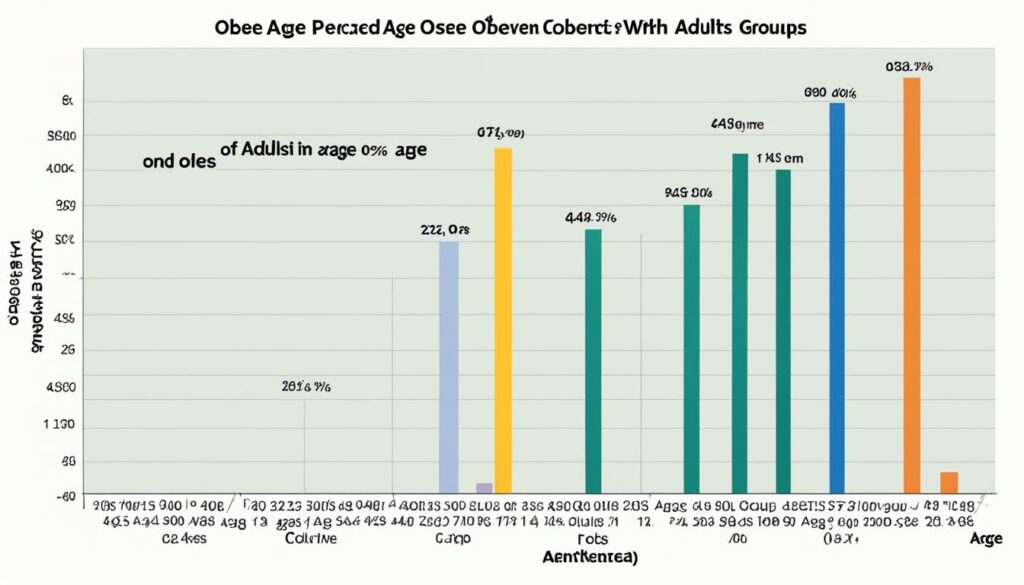As an advocate for a healthier lifestyle, I am committed to following the best practices for obesity prevention. With obesity rates on the rise in the United States, it is crucial to implement effective strategies to combat this prevalent issue. By incorporating nutrition, physical activity, and lifestyle changes into my daily routine, I can significantly reduce the risk of obesity, not just for myself but also for future generations.
Key Takeaways:
- Implementing effective strategies for obesity prevention is essential to combat the rising obesity rates in the United States.
- Focus on incorporating healthy nutrition, regular physical activity, and positive lifestyle changes into daily routines.
- Utilize resources such as the CDC’s guidance on increasing physical activity and promoting healthy eating.
- Early care and education settings play a vital role in obesity prevention by promoting healthy habits.
- Schools can create an environment that supports healthy eating and physical activity through the implementation of school health guidelines.
Nutrition, Physical Activity, and Obesity Prevention Strategies
To effectively prevent obesity, it is essential to focus on nutrition, physical activity, and the implementation of effective strategies. The Centers for Disease Control and Prevention (CDC) provides valuable guidance on increasing physical activity and improving dietary choices to combat obesity.
When it comes to physical activity, the CDC suggests adopting built environment approaches and transportation system interventions. These strategies aim to create environments that encourage and facilitate increased physical activity in our daily lives.
On the nutrition front, the CDC offers a comprehensive guide on increasing the consumption of fruits and vegetables. This guide provides evidence-based strategies to incorporate more nutritious foods into our diets, promoting a balanced and healthy eating pattern.
By incorporating these strategies into our daily routines, we can take significant steps towards preventing obesity. The key is to make sustainable lifestyle changes that prioritize physical activity and healthy eating habits (check out my post on healthy eating habits here).
Strategies for increasing physical activity:
- Engage in regular aerobic exercises, such as walking, swimming, or cycling.
- Incorporate strength training exercises, such as weightlifting or resistance band workouts.
- Take advantage of opportunities for physical activity in your community, such as parks, trails, or recreational facilities.
- Utilize active transportation methods like walking or biking instead of driving for short distances.
Strategies for promoting a healthy diet:
- Increase the consumption of fruits and vegetables, aiming for at least 5 servings per day.
- Limit the intake of sugary beverages and replace them with water or unsweetened drinks.
- Choose whole grains over refined grains for improved nutrient content and fiber intake.
- Reduce portion sizes and practice mindful eating to avoid overindulgence.
Implementing these obesity prevention strategies can significantly reduce the risk of obesity-related health conditions and improve overall well-being (see my post here).
Early Care and Education Strategies

Early care and education settings play a vital role in preventing obesity among children. By implementing effective strategies and promoting healthy lifestyle choices, these settings can contribute to the long-term health and well-being of young learners.
According to the CDC’s Spectrum of Opportunities, there are guidelines and standards specifically designed for early care and education facilities to prevent obesity. These guidelines focus on key areas such as:
- Promoting healthy eating
- Encouraging physical activity
- Managing screen time
“Early care and education settings have the unique opportunity to shape children’s habits and behaviors that can have a lasting impact on their health,” says Dr. Emily Johnson, a pediatrician and obesity prevention expert. “By incorporating these strategies into their daily routines, early care and education providers can foster healthy habits and help prevent obesity in children.”
One example of an obesity prevention strategy implemented in early care and education settings is the provision of nutritious meals and snacks (see my post here). This includes offering a variety of fruits, vegetables, whole grains, and lean proteins while limiting sugary and high-calorie foods. By creating a positive food environment, children are more likely to develop healthy eating habits that can last a lifetime.
In addition to promoting healthy eating, early care and education facilities also prioritize physical activity. They provide ample opportunities for active play and engage children in activities that promote movement, coordination, and gross motor skills. This not only helps prevent obesity but also supports the overall development and well-being of children.
Furthermore, managing screen time is a key component of obesity prevention in early care and education settings. By limiting the use of screens and promoting interactive play and engagement with peers and caregivers, children can develop healthy habits and reduce sedentary behaviors that contribute to obesity.
By implementing these early care and education strategies, we can create an environment that supports children’s health and well-being, preventing obesity through lifestyle changes.
Testimonial:
“As an early childhood educator, I have seen firsthand the positive impact of implementing obesity prevention strategies within our curriculum. By promoting healthy eating, engaging children in physical activities, and limiting screen time, we are not only teaching them essential life skills but also instilling healthy habits that will benefit them throughout their lives.”
– Jane Miller, Early Childhood Educator
School Health Guidelines
Schools play a crucial role in promoting the health and well-being of students. By following the School Health Guidelines, educational institutions can create an environment that supports healthy habits and helps prevent obesity.
The guidelines cover various aspects, including:
- Promoting healthy eating: Schools should prioritize offering nutritious meals and snacks, limiting access to unhealthy foods and beverages, and providing nutrition education.
- Increasing physical activity: Schools can implement strategies to ensure students engage in regular physical activity, such as incorporating physical education classes, recess breaks, and active transportation options.
- Managing chronic health conditions: It’s essential for schools to support students with chronic health conditions by developing individualized plans and providing necessary accommodations to allow participation in physical activity and healthy eating.
By following these guidelines, schools can create an environment that fosters healthy behaviors and helps prevent obesity among students. Implementing policies and practices aligned with the School Health Guidelines ensures that schools prioritize the well-being of their students and provide them with the tools and knowledge needed to maintain a healthy lifestyle.
“Schools have a unique opportunity to shape the health behaviors of students and set them on a path towards lifelong wellness. By following the School Health Guidelines, we can create an environment that supports healthy eating, regular physical activity, and overall well-being.”
Sample Table: Key Recommendations for Schools to Promote Healthy Habits
| Recommendation | Description |
|---|---|
| Promote Healthy Eating | Offer nutritious meals and snacks, limit access to unhealthy foods and beverages, and provide nutrition education. |
| Increase Physical Activity | Incorporate physical education classes, recess breaks, and active transportation options to ensure students engage in regular physical activity. |
| Manage Chronic Health Conditions | Support students with chronic health conditions by developing individualized plans and providing accommodations to facilitate participation in physical activity and healthy eating. |
Implementing these recommendations enables schools to create a supportive environment that promotes healthy habits and contributes to the prevention of obesity.
Community Guide

The Community Guide is an invaluable resource for communities seeking to prevent and control obesity on a local level. It provides evidence-based recommendations for implementing environmental and policy-level changes that promote healthy eating and active living. By adopting these guidelines, communities can make community-wide changes that support obesity prevention and create a healthier environment for their residents.
Successful Approaches to Obesity Prevention
The Community Guide highlights several successful approaches that have proven effective in preventing obesity within communities:
- Implementing community-wide nutrition and physical activity interventions
- Creating supportive environments that encourage healthy eating and active living
- Establishing policies to increase access to healthy foods in community settings
- Promoting healthy food and beverage options in schools and childcare centers
- Encouraging communities to provide safe spaces for physical activity
These approaches have been shown to have a positive impact on obesity rates and can serve as valuable strategies for communities looking to prevent and reduce obesity.
Obesity Prevention Guidelines
The Community Guide offers a comprehensive set of obesity prevention guidelines that can assist local governments and school districts in implementing effective strategies. These guidelines cover a wide range of topics, including:
- Promoting healthy eating and nutrition education
- Increasing access to affordable healthy foods
- Creating environments that support physical activity
- Reducing sugary drink consumption
- Implementing comprehensive school-based obesity prevention programs
- Encouraging breastfeeding
By following these guidelines, communities can take important steps in preventing obesity and improving the overall health of their residents.
Programs and Policies for Community-Wide Obesity Prevention
| Programs | Policies |
|---|---|
| Community-based physical activity programs | Implementing zoning regulations to increase access to healthy foods |
| Worksite wellness initiatives | Creating policies to restrict marketing of unhealthy foods to children |
| Healthy food retail strategies | Establishing nutrition standards for foods and beverages sold in government buildings |
| Active transportation initiatives | Implementing policies to increase access to drinking water in public places |
The table above showcases examples of programs and policies that communities can implement to promote obesity prevention. By combining both programmatic and policy-level approaches, communities can create a comprehensive strategy that addresses the root causes of obesity and promotes healthier lifestyles (check this post out).
Clinical Guidelines

Clinical guidelines are essential tools in the healthcare setting for addressing obesity prevention. They provide evidence-based recommendations and interventions that healthcare professionals can utilize to effectively manage and prevent obesity.
A notable resource for clinical guidelines in obesity prevention is the Expert Panel on Integrated Guidelines for Cardiovascular Health and Risk Reduction in Children and Adolescents. This panel provides comprehensive guidance to healthcare providers on screening for obesity, as well as offering weight management interventions.
Another significant source of clinical guidelines is the American Academy of Pediatrics. They have developed clinical practice guidelines specifically for the evaluation and treatment of children and adolescents with obesity. These guidelines ensure that healthcare professionals have the necessary knowledge and tools to provide effective care and support in addressing obesity.
By following these clinical guidelines, healthcare providers can make informed decisions and implement appropriate interventions to prevent and manage obesity in their patients. The integration of these guidelines into clinical practice is crucial for achieving successful outcomes in obesity prevention.
Obesity Statistics

Obesity rates have been steadily increasing in both children and adults. According to recent data, approximately 19.7% of children and over 41% of adults in the United States are considered obese. These statistics highlight the urgent need to address the growing issue of obesity across all age groups.
Childhood obesity is particularly alarming as it sets the stage for long-term health complications. The prevalence of childhood obesity has more than tripled in the past four decades, making it a significant public health concern.
Adult obesity rates are also a cause for concern. Obesity increases the risk of numerous chronic conditions, including heart disease, diabetes, and certain types of cancer.
The longer a person stays obese, the higher their risk becomes for various obesity-related health conditions. Prevention is crucial, as obesity can be challenging to treat once it develops. By focusing on preventative measures and promoting healthy lifestyle choices, we can curb the rising obesity rates and improve overall population health.
The Impact of Obesity
Obesity not only affects physical health but also has far-reaching consequences on mental well-being and quality of life. Individuals who are obese often face discrimination and social stigma, leading to feelings of isolation and low self-esteem.
“Obesity is a complex health issue that requires a multi-faceted approach. By addressing the underlying causes and promoting healthy habits, we can make a significant impact on reducing obesity rates and improving overall health outcomes,” says Dr. Emily Thompson, a renowned expert in obesity prevention.
Addressing the Obesity Epidemic
It is imperative to tackle the obesity epidemic through a combination of individual, community, and policy-level interventions. An integrated approach that focuses on nutrition education, increased physical activity, and creating supportive environments can make a significant difference.
“Prevention is the key to reducing the prevalence of obesity in our society. By implementing evidence-based strategies and interventions, we can empower individuals and communities to make healthier choices and create a culture of wellness.”
Efforts to prevent obesity should start early in life, focusing on children and adolescents. By implementing school-based programs, promoting healthy eating habits, and encouraging regular physical activity, we can set the foundation for a healthy adulthood.
Additionally, community-wide initiatives, such as improved access to affordable healthy food options and creating safe spaces for physical activity, can further support efforts to prevent obesity.
| Age Group | Obesity Rate |
|---|---|
| Children (2-19 years old) | 19.7% |
| Adults (20 years and older) | 41% |
Childhood Obesity Prevention

Preventing childhood obesity is a crucial step in ensuring the long-term health and well-being of our children. Childhood obesity not only poses immediate health risks but also increases the likelihood of obesity persisting into adulthood, leading to a higher risk of chronic diseases such as diabetes and heart disease.
To effectively prevent childhood obesity, several key recommendations can be implemented:
- Promote healthy eating habits: Encourage children to consume a balanced diet, rich in fruits, vegetables, whole grains, and lean proteins. Limit the consumption of sugary beverages, processed foods, and high-fat snacks.
- Encourage physical activity: Ensure children engage in at least 60 minutes of moderate to vigorous physical activity every day. This can include activities such as playing sports, riding bikes, or simply taking walks with the family.
- Be a positive role model: Lead by example and demonstrate healthy lifestyle behaviors. Children are more likely to adopt healthy habits when they see their parents and caregivers engaging in them.
- Limit screen time: Set limits on the amount of time children spend in front of screens, including TVs, computers, tablets, and smartphones. Encourage alternative activities such as reading, playing outdoors, or engaging in creative play.
- Create a supportive family environment: Establish a supportive and nurturing family environment that promotes healthy choices. This can include involving children in meal planning and preparation, offering nutritious snacks, and providing opportunities for physical activity.
By implementing these recommendations, parents and caregivers can significantly reduce the risk of childhood obesity and cultivate a foundation for a healthy lifestyle. It is essential to remember that small changes can make a big difference in the long run. Together, we can create a healthier future for our children.
The Impact of Childhood Obesity
Childhood obesity can have severe consequences on both physical and psychological health. Immediate health risks include an increased likelihood of developing type 2 diabetes, high blood pressure, and elevated cholesterol levels. Additionally, obese children often face social and emotional challenges, such as low self-esteem and depression.
It is crucial to address childhood obesity through preventive measures, as treatment becomes more challenging once obesity is established. By focusing on promoting healthy eating habits, encouraging physical activity, and creating a supportive environment, we can make a significant impact on the well-being of our children.
| Immediate Health Risks | Long-Term Health Risks |
|---|---|
| Increased risk of type 2 diabetes | Higher risk of obesity persisting into adulthood |
| High blood pressure | Greater likelihood of developing chronic diseases |
| Elevated cholesterol levels | Increased risk of cardiovascular disease |
| Social and emotional challenges | Psychological impacts, such as low self-esteem and depression |
Conclusion
In conclusion, effective obesity prevention requires a comprehensive approach that addresses nutrition, physical activity, and policy changes across various settings. By implementing best practices and strategies, such as promoting healthy eating habits, increasing physical activity, and creating supportive environments, we can make significant strides in preventing obesity. It is imperative for individuals, communities, and healthcare providers to collaborate and foster a culture of obesity prevention to pave the way for a healthier future.
When it comes to nutrition, focusing on a well-balanced diet that includes a variety of fruits, vegetables, whole grains, and lean proteins is essential. Encouraging portion control and minimizing the consumption of sugary beverages and processed foods can also contribute to obesity prevention.
Additionally, engaging in regular physical activity and finding enjoyable ways to stay active, such as walking, biking, or participating in sports, can help maintain a healthy weight and reduce the risk of obesity. Creating environments that promote physical activity, such as safe and accessible recreational spaces, can further support these efforts.
By implementing these practices and working together, we can effectively address the obesity epidemic and create a healthier future for individuals, families, and communities. Let us prioritize obesity prevention and embrace the positive changes that result from it.




